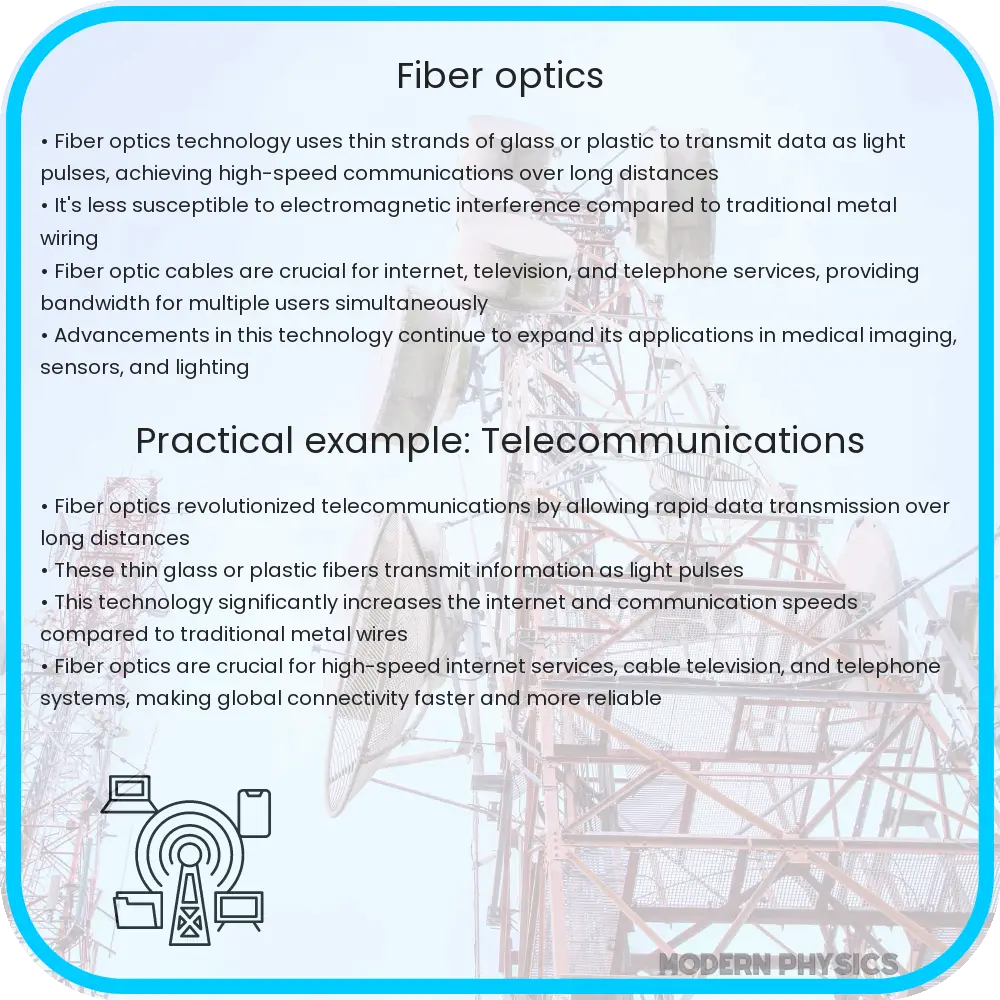Explore the efficiency, speed, and precision of fiber optics in communication, their advanced applications, and future trends in technology.

Understanding Fiber Optics: Geometrical Efficiency, Speed, and Precision
Fiber optics represent a cornerstone technology in modern communication systems, offering unparalleled advantages in terms of geometrical efficiency, speed, and precision. This technology, fundamentally based on the principles of light propagation through thin strands of glass or plastic fibers, has revolutionized how we transmit data, be it for internet, television, or telephone services.
Geometrical Efficiency of Fiber Optics
The geometrical efficiency of fiber optics lies in their ability to transmit a high volume of data over long distances with minimal physical space. Unlike traditional copper wires, optical fibers are incredibly thin, often not much thicker than a human hair. This allows for a multitude of fibers to be bundled together in cables, providing high bandwidth in a compact size. This efficiency is not only crucial in dense urban areas but also beneficial for undersea cables, where space and weight are critical factors.
Speed: The Backbone of Fiber Optic Technology
Speed is arguably the most significant advantage of fiber optic technology. Optical fibers transmit data at the speed of light in glass, which is approximately 200,000 kilometers per second. This is only about 31% slower than the speed of light in a vacuum (c = 299,792 kilometers per second). Such speed is achievable due to the low levels of signal degradation and the absence of electromagnetic interference, common in metal cables. The result is faster data transmission over longer distances, making fiber optics ideal for high-speed internet connections and real-time data processing.
Precision and Data Integrity in Fiber Optics
Precision in fiber optics refers to the technology’s ability to maintain the integrity and quality of the data being transmitted. Fiber optics are less susceptible to noise and signal loss, primarily because light waves are less likely to interfere with each other compared to electrical signals in traditional wires. This results in clearer, more reliable communication with fewer errors. Additionally, fiber optics offer better security, as they are immune to electromagnetic interference and are more difficult to tap into without detection.
The remarkable properties of fiber optics, such as minimal signal loss and electromagnetic immunity, are largely attributed to the unique physics of light propagation. Light in fiber optics travels through the core of the fiber by a process called total internal reflection. This process ensures that light signals stay confined within the fiber, maintaining signal strength and integrity over long distances.
Advanced Applications of Fiber Optics
Fiber optics have found their way into various advanced applications beyond traditional communication systems. In the medical field, they are used in endoscopy, providing high-resolution images inside the human body. In environmental monitoring, fiber optics are employed in remote sensing devices to detect pollutants and changes in environmental conditions. The aerospace industry utilizes fiber optics for data transmission in aircraft, leveraging their resistance to electromagnetic interference and lightweight nature.
Future Trends and Developments in Fiber Optic Technology
The future of fiber optics looks promising, with ongoing research aimed at further enhancing their capabilities. Developments in fiber optic technology include the creation of fibers with even lower loss rates and higher bandwidth capacities. Innovations like photonic crystal fibers are opening new realms in controlling light propagation, leading to more efficient and versatile optical fibers. Additionally, there is a growing trend in integrating fiber optic technology with renewable energy systems, particularly in the development of smart grids and renewable energy distribution networks.
Conclusion
Fiber optic technology stands as a testament to human ingenuity in the field of communication and beyond. Its remarkable properties of geometrical efficiency, speed, and precision have not only revolutionized data transmission but have also paved the way for innovations across various industries. From providing the backbone of the internet to aiding medical diagnoses, fiber optics continue to expand their impact. The ongoing advancements in this field promise to deliver even more groundbreaking applications, further solidifying the role of fiber optics in shaping the future of technology and communication. As we move forward, the integration of fiber optics with emerging technologies and renewable energy systems is likely to play a pivotal role in driving sustainable growth and innovation worldwide.
